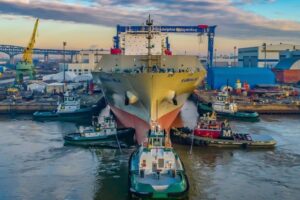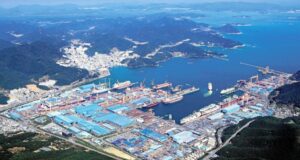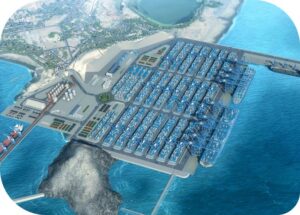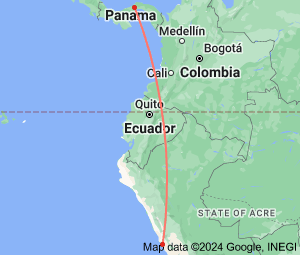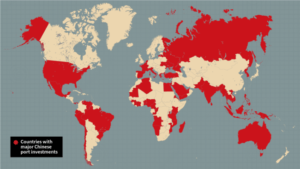 Countries With Chinese Port Investments In Red 5
Countries With Chinese Port Investments In Red 5
IN THIS REPORT:
U.S. NEEDS TO SUPPORT ITS ALLIES IN THE PACIFIC
CHINA’S IMPACT ON U.S. ALLIES IN THE PACIFIC
- South Korea and Japan
- Taiwan
- The Philippines
- Australia
- Peru
- Mexico
CONCLUSION
BY STAS MARGARONIS, RBTUS
The new strategy being championed by U.S. Navy Secretary Carlos Del Toro is to develop collaborations with Japanese and Korean shipbuilders so as to encourage them to invest in the United States. One result of this effort is that Korea-based Hanwha Systems and Hanwha Ocean announced the acquisition of Philly Shipyard, a leading U.S. shipbuilder that has delivered approximately half of the large U.S. Jones Act commercial ships in the United States since 2000.
Philly Shipyard
Hanwha Ocean is a leading global company with extensive expertise in the shipbuilding and the offshore industry. Since 1973, the company (formerly Daewoo Shipbuilding & Marine Engineering) has produced a vast range of vessels, including commercial ships, drill ships, and specialty ships.[6]
Hanwha Shipyard South Korea
It is one of the top shipbuilders in South Korea.
However, the United States needs to do more to support its allies in the Pacific if these collaborations are to continue.
Japan’s Nikkiei Asia has provided some of the best reporting on developments in China and the progress of China’s expansionism in Asia. The Japanese news service recently reported on a growing crisis of confidence among America’s allies in Asia caused by “uncertainty over the U.S. election in November and the potential for a second Donald Trump presidency. His isolationist rhetoric has raised concerns that his administration may be less likely to defend Taiwan in a military crisis with China, or support South Korea in a contingency with North Korea.”[7]
The concern of America’s Asian allies was heighted during the June 27th presidential debate between President Joe Biden and his Republican challenger Donald Trump. Trump continued to express his admiration for Russian President Vladimir Putin but not for U.S. allies in Europe who fear Russia’s invasion of Ukraine could also threaten Poland and the rest of Europe.
A New York Times report noted: “Amid a faltering performance by President Biden in the presidential debate Thursday night, former President Donald J. Trump caused anxiety among America’s allies with a simple shrug. Mr. Trump has regularly disparaged NATO and even threatened to withdraw the United States from it, and during the debate, he did nothing to assuage European concerns about his antipathy toward the military alliance. Asked by Mr. Biden if he would pull out of NATO, Mr. Trump did not answer but shrugged.”[8]
CHINA’S IMPACT ON U.S. ALLIES IN THE PACIFIC
Here is an update on how China is impacting U.S. allies around the Pacific:
South Korea and Japan. In June, Russian President Vladimir Putin and North Korean leader Kim Jong Un signed a new strategic partnership. North Korea, with China’s support, is intensifying military and political threats to U.S. allies: Japan and South Korea. The new pact requires Russia and North Korea to use all available means to provide immediate military assistance in the event of war. This could impact South Korea, Japan or the United States.[9]
Taiwan. On June 24th, Taiwan’s President Lai Ching-te signed into law a controversial reform expanding parliament’s powers, but vowed to seek a ruling from the island’s top court to try to overturn it: “Proponents of the expansion say it is needed to curb corruption, but critics fear the laws could weaken self-ruled Taiwan’s democracy against the influence of China — which claims the island as part of its territory. Taiwan’s president is part of the Democratic Progressive Party (DPP), which advocates for the island’s sovereignty. But it lost the parliamentary majority in January elections, spelling trouble for his administration. The reform bills passed had sparked massive protests on the island.” The opposition Kuomintang (KMT) party and Taiwan People’s Party have argued that the expanded parliamentary powers are needed to curb corruption. The KMT, regarded as pro-Beijing, called on Lai to “bravely face the parliament and face the people” rather than seek to block the legislation.[10]
The pro-China KMT and their allies could be a political force for legalizing unification with China without having China resort to an invasion.
Added to this are concerns that Donald Trump is not committed to coming to Taiwan’s aid if it is attacked: This was reflected in a Nikkei Asia report: “In Taiwan, a comment made by Trump in a July 2023 interview with Fox News still lingers in the minds of many observers. When asked by anchor Maria Bartiromo whether the U.S., under a potential second Trump presidency, would protect Taiwan from Chinese aggression, even if it meant going to war with China, the Republican former president did not give a direct answer …”If I answer that question, it will put me in a very bad negotiating position,” Trump said. “With that being said, Taiwan did take all of our chip business. We used to make our own chips. Now they’re made in Taiwan.”[11]
Aside from the loss of democratic rights for 24 million Taiwanese, Taiwan’s unification with China would also undermine the independence of East and South-East Asian nations such as Japan, South Korea, the Philippines, Vietnam, Cambodia, Laos, Indonesia, Singapore, Australia, New Zealand, Guam and the South Sea Pacific islands.
From a technological standpoint, unification could deny the United States and other nations the ability to source semiconductors from Taiwan.
The loss of Taiwan’s semiconductor producers including Taiwan Semiconductor Company (TSMC) would plunge the United States and other nations into a global depression, according to the conservative Hudson Institute:
“According to a new study, losing access to Taiwan’s semiconductor industry would have a negative impact on the U.S. economy greater than either the global financial crisis of 2008 or the COVID lockdown of 2020. A significant disruption to Taiwan’s semiconductor industry could affect as much as $1.6 trillion, or roughly 8%, of America’s annual gross domestic product — hurting industries like personal electronics, automotives and telecommunications. And even this estimate may be low, considering how our lives, from farming to health care, are increasingly reliant on new technologies that require more advanced chips.” (See: https://www.hudson.org/technology/losing-taiwan-semiconductor-would-devastate-us-economy-riley-walters)
Taiwan Semiconductor Manufacturing Company (TSMC), the global leader of advanced semiconductors that are also being used in AI applications. Under the Biden administration, TSMC is now building semiconductor manufacturing facilities in Arizona financed by the CHIPS Act with $6.6 billion in U.S. funding:
TSMC said in a media release:” As the company makes progress in completing its first fab and continues construction of its second fab at its Arizona subsidiary, the third fab brings TSMC’s total capital expenditure for the Phoenix, Arizona site to more than US$65 billion, making the site the largest foreign direct investment in Arizona history, and the largest foreign direct investments in a greenfield project in U.S. history.”[12]
On June 8th Nvidia Corp. cofounder Jensen Huang said that he was not making a geopolitical comment after a Chinese state media firm criticized him for calling Taiwan a country. According to the Taipei Times: “…On May 29, Huang told reporters that ‘Taiwan is one of the most important countries in the world. It is at the center of the electronics industry. The computer industry is built because of Taiwan.’ In a speech at National Taiwan University on June 2nd, Huang displayed a map of Taiwan surrounded by the names of Taiwanese companies and institutes Nvidia has partnered with, thanking them for being the “bedrock for the AI [artificial intelligence] industrial revolution.”[13]
Huang was born in Taiwan and when Nvidia was founded, ‘it relied on Taiwanese partners, including TSMC.’”[14]
In March 2024, Robert Gates, former Secretary of Defense under Presidents Bush and Obama and a former CIA Director warned a Trans Pacific Maritime conference at Long Beach, California that China could disrupt Taiwan’s air and sea trade indefinitely. Gates said that following former U.S. House Speaker Nancy Pelosi’s visit to Taiwan in 2022, China retaliated by initiating exercises that disrupted Taiwan’s economy. This strategy could be utilized long-term as China “directed exercises to be carried out by both naval and air forces … around Taiwan. And they declared exercise areas on the maritime approaches to Taiwan and also on the air corridor. So that for a period of a week or two commercial traffic in and out of Taiwan was pretty significantly disrupted. The Chinese can declare those exercise areas any time they want, for any length of period they want, and it’s not something that is going to provoke a U.S. military reaction or even a Taiwanese military reaction, but it could be very disruptive for Taiwan’s economy.”[15]
The Philippines. Under the leadership of President Ferdinand Marcos, the Philippines have defended their territorial waters as China has stepped up its presence in contested waters of the South China Sea.
To add to Marcos’ problems, Philippine Vice President Sara Duterte has resigned from her cabinet post and is distancing herself from Marcos’ policies including his defense of territorial waters in the South China Sea. Duterte could be the candidate to support Beijing and oppose the United States in the next presidential election.
However she faces some hurdles, according to a June 24th report in the South China Morning Post: “But her progress could be impeded by previous controversies, including allegations surrounding her past use of public funds and her silence on maritime tensions with Beijing in the South China Sea, according to Sherwin Ona, an associate professor of political science at De La Salle University in Manila: “It remains to be seen if she can fashion herself as one [an opposition figure] given her political baggage,” he said, citing “her pro-Beijing stance”, “allegations of corruption related to intelligence funds” and the pending International Criminal Court case against her father’s deadly war on drugs.” (see:https://www.scmp.com/week-asia/politics/article/3267755/sara-dutertes-political-pivot-marcos-ally-leader-opposition)
On June 19th, the Philippines Department of Foreign Affairs said: “The Department of Foreign Affairs (DFA) on Wednesday denounced the “illegal and aggressive actions” of the Chinese near the Ayungin Shoal on June 17, which severely injured a Philippine Navy personnel and damaged Filipino vessels. In a statement, the DFA expressed “grave concern” over the incident that happened during a humanitarian mission to the BRP Sierra Madre. Before the incident, the agency lamented the Philippines had been working to “rebuild a conducive environment for dialogue and consultation” with China on the South China Sea. “This cannot be achieved if China’s words do not match their actions on the waters …”[16]
On July 2nd, the Philippine Coast Guard (PCG) said that China’s largest Coast Guard vessel had anchored in Manila’s exclusive economic zone (EEZ) in the South China Sea, and is meant to intimidate its smaller Asian neighbor. The Chinese Coast Guard’s 165-meter ‘monster ship’ entered Manila’s 200-nautical mile EEZ, Jay Tarriela, spokesperson for the PCG, told a news conference. [17]
However on July 21, 2024, the Philippines said it has “reached an understanding” with China on resupply missions to a beached Filipino naval ship that has been a key flashpoint between the two countries in the South China Sea.The Chinese foreign ministry confirmed the “temporary arrangement” with the two sides agreeing to jointly manage maritime differences and de-escalate the situation in the South China Sea, according to a Guardian report.
The Chinese foreign ministry confirmed the arrangement, adding: “The Chinese side still demands that the Philippine side tow away the ship and restore the original status of [Second Thomas Shoal] as if it were unmanned and without facilities,” a spokesperson said in a statement released early on Monday. “If the Philippines needs to provide supplies to the ship’s occupants before the Philippines tows away the beached warship, the Chinese side is willing to allow the Philippine side to carry out the transportation and replenishment on humanitarian grounds,” the spokesperson said.
On July 22, 2024, Philippine foreign ministry spokesperson Teresita Daza said in a statement that Manila would “continue to assert our rights and jurisdiction in our maritime zones”, which included Second Thomas Shoal.The foreign ministry also rejected suggestions by China that the “provisional arrangement” announced on Sunday required Manila to give Beijing “prior notification” and verification of deliveries to the BRP Sierra Madre, reports Agence France-Presse.
(See:https://www.theguardian.com/world/article/2024/jul/22/china-and-philippines-deal-south-china-sea-sierra-madre)
On May 3, 2023, U.S. Secretary of Defense Lloyd J. Austin III and Philippine Secretary of the Department of National Defense Carlito Galvez established the Bilateral Defense Guidelines to modernize alliance cooperation in service of the United States and the Philippines. The guidelines reaffirm that “an armed attack in the Pacific, including anywhere in the South China Sea, on either of their public vessels, aircraft, or armed forces – which includes their Coast Guards – would invoke mutual defense commitments under Articles IV and V of the 1951 U.S.-Philippines Mutual Defense Treaty.”[18]
Reuters reported on July 5th that the Philippines has turned down offers from the United States to assist operations in the South China Sea, after a flare-up with China over missions to resupply Filipino troops on a contested shoal, its military chief said. The US, a treaty ally, has offered support but Manila prefers to handle operations on its own, Armed Forces Chief General Romeo Brawner told Reuters: “Yes, of course, they have been offering help and they asked us how they could help us in any way,” he said. “We try to exhaust all possible options that we have before we ask for help.” Manila and Washington are bound by the 1951-Mutual Defense Treaty (MDT).”[19]
Australia. On June 17th, relations between China and Australia, strained by years of acrimony, were reported “on the right track,” by Chinese Premier Li Qiang … during an appearance with Australian Prime Minister Anthony Albanese, who emphasized “renewed and revitalized” engagement between the two countries. Li, President Xi Jinping’s second-in-command, was in Australia for a four-day trip that marks the first by a Chinese premier since his predecessor Li Keqiang’s visit seven years ago.
According to Nikkei Asia: “China in 2020 hit Australia with $20 billion Australian dollars ($13.2 billion) worth of trade restrictions after taking umbrage with former prime minister Scott Morrison’s call for an independent probe into the origins of COVID-19. Most of those barriers, including high tariffs on Australian wine and barley, as well as restrictions on timber, coal and copper, have been removed in recent months, although curbs on rock lobster exports and two beef exporters remain.”[20]
The trip follows an effort to “stabilize” the relationship, which nosedived under Australia’s previous government and still faces pressure amid increasing geopolitical tension in the region between China and Western nations.[21]
Peru. President Dina Boluarte’s government says the Peruvian government has backed off efforts to exert control and sovereignty over a $1.3 billion mega port being built by a Chinese state-owned company on Peru’s Pacific coast. China Ocean Shipping Company, (COSCO) has been building the Chancay port near Lima and expecting to be its exclusive operator when it opens in November. However, Bloomberg reported: “But (Peruvian) government lawyers sued to challenge that status earlier this year, saying the facility should be available to other companies offering services such as loading and unloading shipping containers. The surprise lawsuit was criticized by the company, Chinese lenders and Peruvian industry groups that argued virtually all other ports in the South American country have exclusive operators. President Dina Boluarte’s government now says the lawsuit will be dropped. The Chancay port is expected to transform trade between South America and Asia by slashing travel times for cargo ships. The facility, which has become a lightning rod for US-China tensions in the region, is due to be inaugurated when Peru hosts the Asia-Pacific Economic Cooperation leaders’ summit later this year.”[22]
Rendering: Chancay Megaport, Peru
Privately, one ocean carrier representative is worried that the new port will not only give China’s COSCO more control over Asian trade with South American countries but it could also be followed by the establishment of a Chinese naval base located within a short sailing distance of the Panama Canal.[23]
Port of Chancay to Panama
Mexico. There is an increase in Chinese shipments to Mexico coinciding with the imposition of tariffs by the Trump and Biden Administrations. In a May 14th, Atlantic Council report, Josh Lipsky, senior director noted: “Biden administration officials are trying to avoid repeating the mistakes of past decades when, they believe, the United States (and its allies) did not do enough to counter China’s unfair trade practices until it was too late and Chinese products flooded markets and cost jobs. Now they want to get ahead of the curve, especially on EVs (electric vehicles) with a staggering 100 percent tariff. It’s worth noting that only 1 percent of all US EV imports currently come from China —so this is about the future, not about now. It’s not that China hasn’t been creating overcapacity for decades; it’s that the sectors China is now doing it in are considered critical for national security.”[24]
In the April 2024 issue of the Pacific Merchant Shipping Association (PMSA) West Coast Trade Report, economist Jock O’Connell noted: “Chinese shipments to Mexico’s two top Pacific Coast ports have been steadily increasing and have been exceptionally brisk in recent years. Volumes rose more than six-fold to 137,874,618 metric tons in 2023 from 21,154,509 metric tons just ten years before … Growth has been particularly fast in the automotive sector. It is a share that is apt to grow due to the presence in Mexico of Chery and BYD, two of China’s premier manufacturers of electric vehicles. So, yes, the fact that Chinese companies are expanding their manufacturing capacity in Mexico will ultimately affect business at USWC (U.S. West Coast) ports.”[25]
In May, Daniel Hackett of Hackett Associates, which produces the monthly “Global Port Tracker” report for the National Retail Federation (NRF) noted a rise in truckloads of Chinese imports coming into the United States through Mexico:
“Another thing that we’ve been seeing recently is that Mexico … became the number one trade partner with the U.S. And there is a large volume of cargo coming in from China into Mexico and then being trucked across the border. If you look at … the first quarter of 2024 at Laredo (Texas), they had almost a doubling of the number of … loaded trucks with containers or loaded container trucks crossing the border to about 1.2 million in the first quarter. So, if that trend continues, that might be … stunting the growth … at some of the other (U.S.) ports where those imports from China typically occur. Now, this is still small volumes, obviously, but it is something that we are keeping an eye on.”[26]
CONCLUSION
Collaborations between the United States and its Asian allies in shipbuilding, container crane development, semiconductor manufacturing, steel-making, hydrogen fuel cell development and wind energy are on the rise. These collaborations will create new economic and maritime development.
At the same time, the United States needs to defend the independence of its allies in Asia, Europe and elsewhere and make good on its treaty obligations to come to the aid of countries who are facing threats from their neighbors.
A role model for enhancing collaboration is Nvidia Corp. Cofounder Jensen Huang was born in Taiwan and has built up Nvidia as an AI leader in the United States. While visiting Taiwan in June, Huang cited the importance of Taiwanese semiconductor manufacturers including TSMC for their support in building up Nvidia.
Huang’s example demonstrates the success of the Pacific Rim Collaboration.
FOOTNOTES
[5] https://www.voanews.com/a/6224958.html
6) ] https://www.hanwha.com/newsroom/news/press-releases/hanwha-acquires-philly-shipyard-expanding-its-footprint-in-global-shipbuilding-and-deployment-of-naval-systems.do
[7] https://asia.nikkei.com/Business/Markets/Wealth-Management/China-to-see-biggest-millionaire-exodus-in-2024-as-many-head-to-U.S
[8] https://www.nytimes.com/2024/06/28/world/europe/biden-trump-debate-europe.html
[9] https://apnews.com/article/russia-north-korea-putin-kim-agreement-7221909867dbb999de8adb23604e3c79
[10] https://www.barrons.com/news/taiwan-president-seeks-to-overturn-controversial-reform-173523c9
[11] https://asia.nikkei.com/Politics/U.S.-elections-2024/Would-a-Trump-presidency-change-China-s-calculations-on-Taiwan
[12] https://pr.tsmc.com/english/news/3122
[13] https://www.taipeitimes.com/News/taiwan/archives/2024/06/09/2003819096
[14] Ibid
[15] https://www.ajot.com/insights/full/ai-former-defense-secretary-gates-says-suez-disruptions-could-last-indefinitely
[16] https://www.pna.gov.ph/articles/1227213
[17]https://gcaptain.com/china-anchors-monster-ship-in-south-china-sea/?subscriber=true&goal=0_f50174ef03-a495d32c21-169966254&mc_cid=a495d32c21&mc_eid=f4fd64d0a0
[18] https://www.defense.gov/News/Releases/Release/Article/3383607/fact-sheet-us-philippines-bilateral-defense-guidelines/
[19] https://gcaptain.com/philippines-turned-down-us-help-amid-south-china-sea-tensions/?subscriber=true&goal=0_f50174ef03-a495d32c21-169966254&mc_cid=a495d32c21&mc_eid=f4fd64d0a0
[20] https://asia.nikkei.com/Politics/International-relations/Chinese-Premier-Li-Qiang-says-ties-with-Australia-are-back-on-track
[21] Ibid
[22] https://gcaptain.com/peru-concedes-in-port-spat-with-china-cosco/?subscriber=true&goal=0_f50174ef03-73da33b82a-169966254&mc_cid=73da33b82a&mc_eid=f4fd64d0a0
[23] Conversation with the author March, 2024.
[24] https://www.ajot.com/insights/full/ai-seroka-says-chinese-box-volumes-via-mexico-not-a-problem-for-la
[25] Ibid
[26] Ibid

